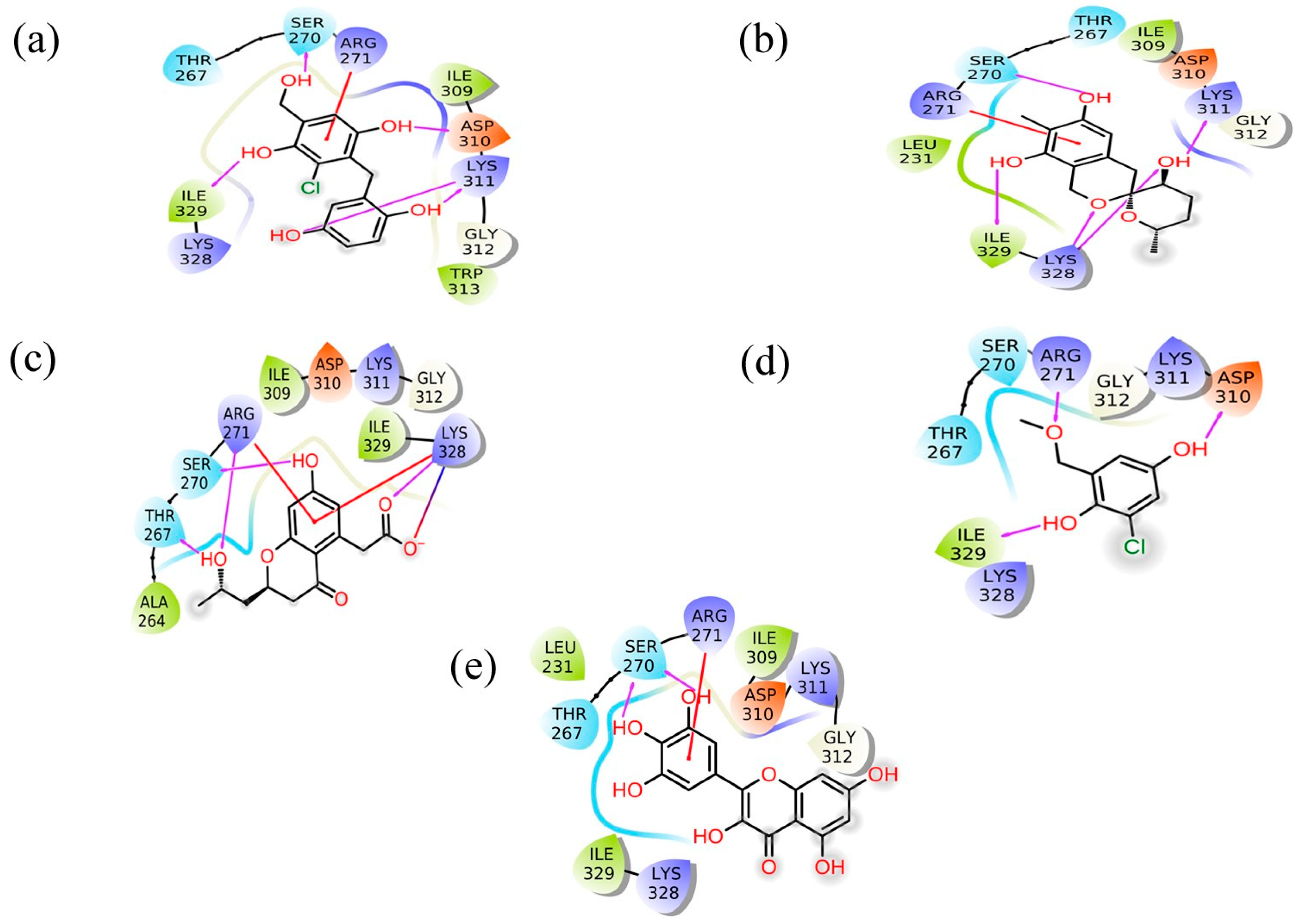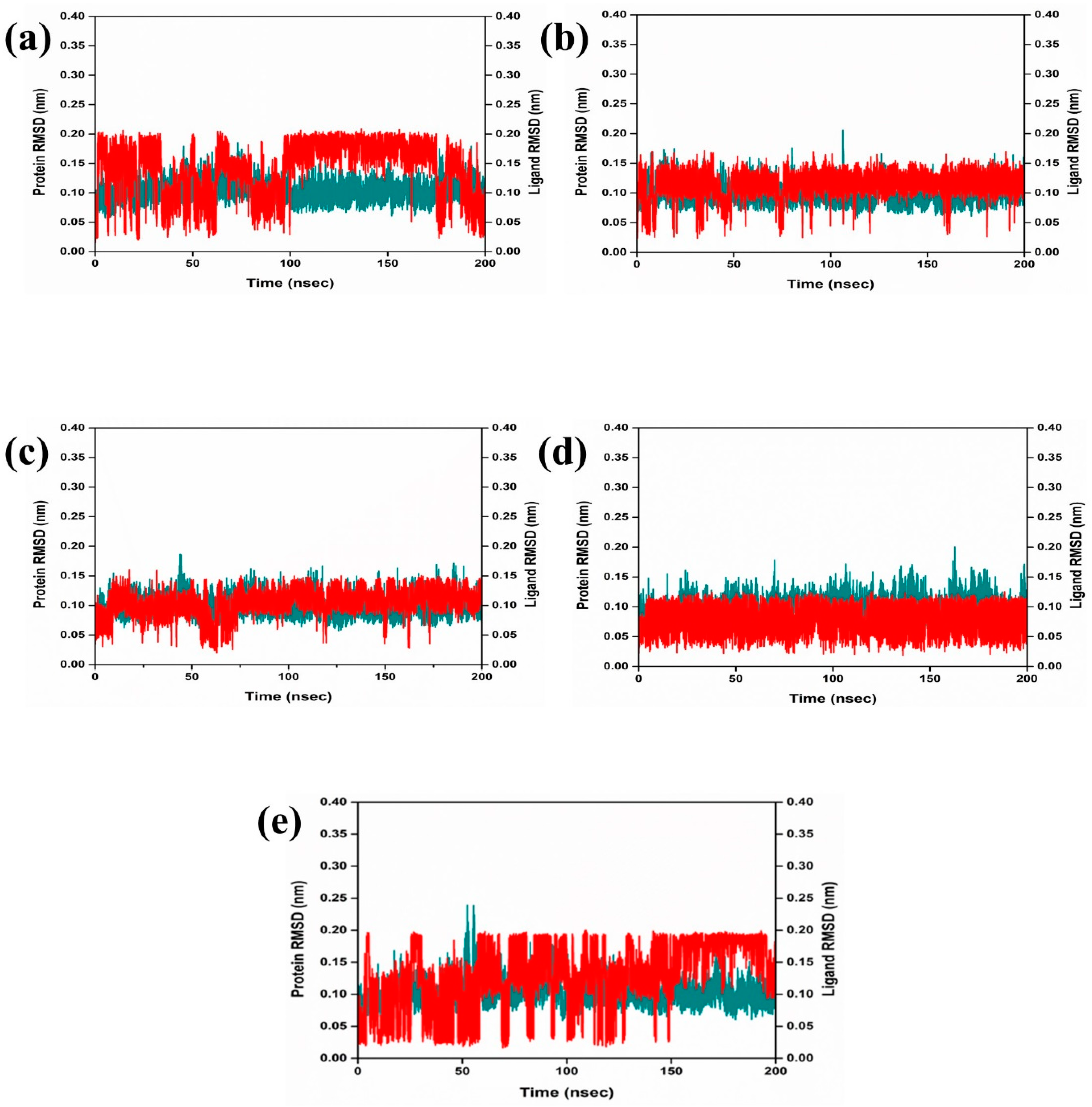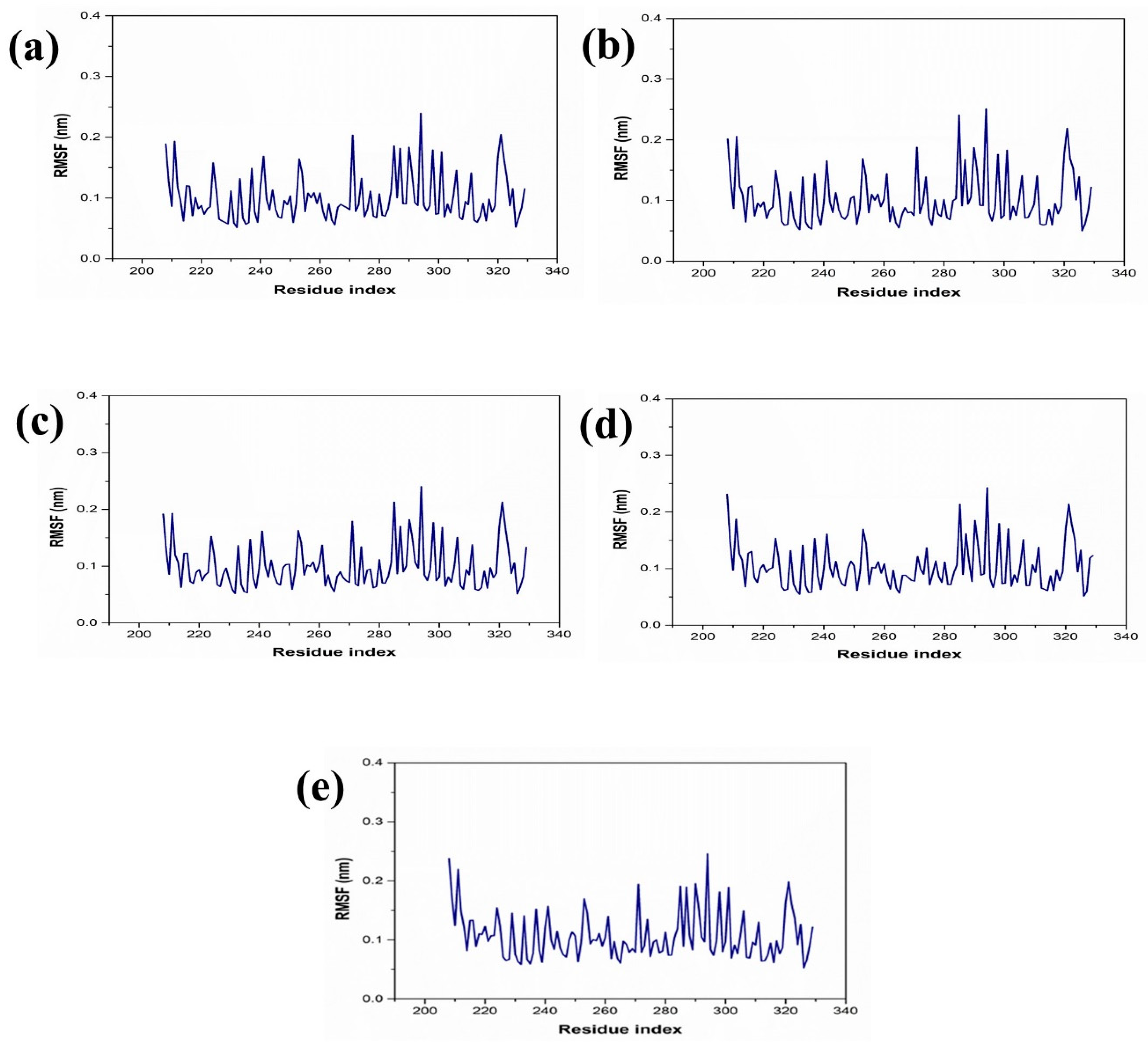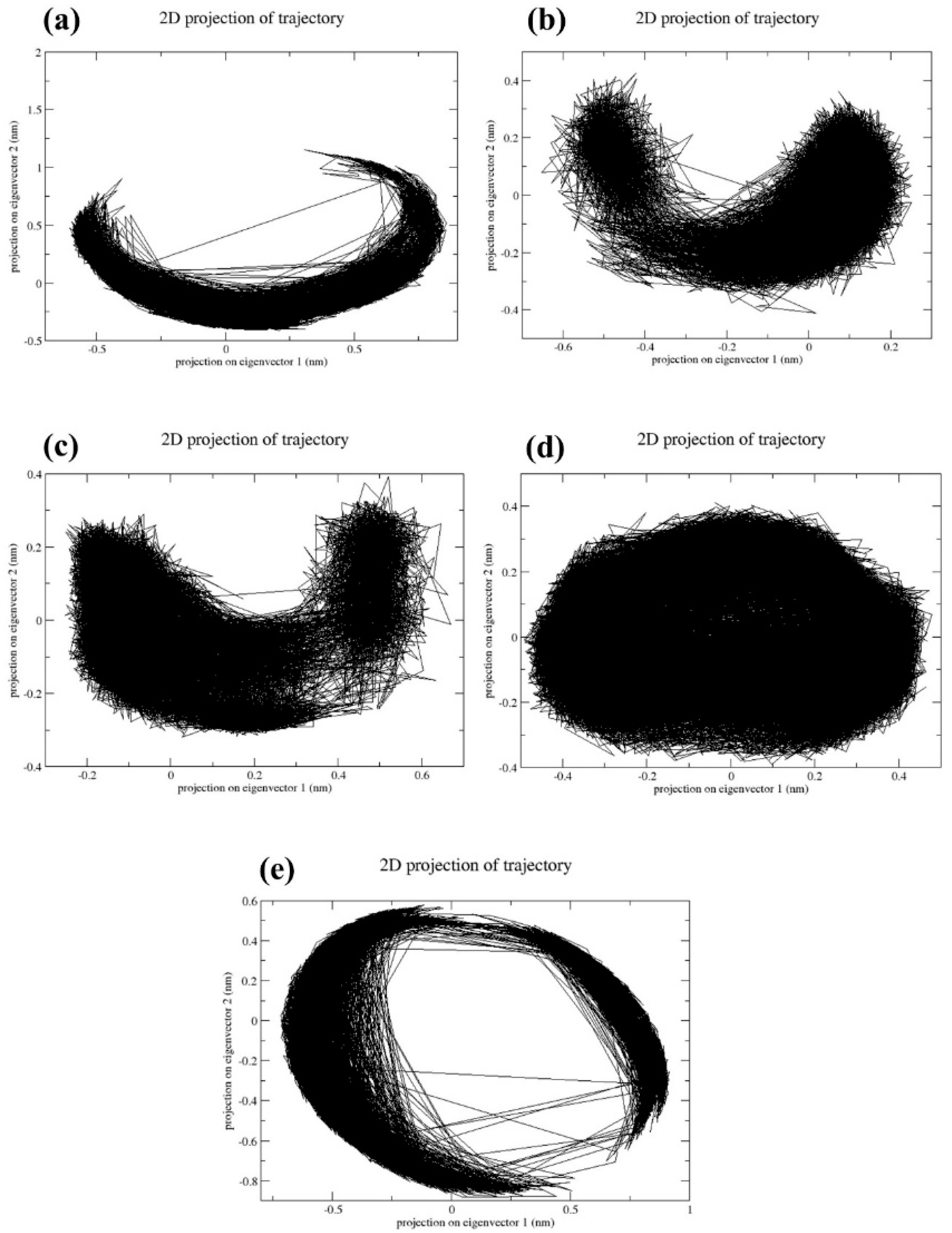Structural and Dynamical Basis of VP35-RBD Inhibition by Marine Fungi Compounds to Combat Marburg Virus Infection
Abstract
1. Introduction
2. Results
2.1. Virtual Screening and Re-Docking
2.2. Molecular Interaction Analysis of the Docked Complexes
2.3. Molecular Dynamics Simulation and Trajectory Analysis
2.3.1. RMSD and RMSF Analysis
2.3.2. Number of Hydrogen Bond Analysis
2.4. Principal Component Analysis
2.5. Free Energy Landscape
3. Discussion
4. Methodology
4.1. Data Collection, Virtual Screening, and Re-Docking
4.2. Molecular Dynamics Simulation and Trajectory Analysis
4.3. PCA-Based Free Energy Landscape
5. Conclusions
Supplementary Materials
Author Contributions
Funding
Institutional Review Board Statement
Data Availability Statement
Conflicts of Interest
References
- Oduoye, M.O.; Mujtaba, A.; Kaushik, I.; Ibezim, G.O.; Dave, T.; Marsool, M.D.M.; Kumar, D.; Ogunleye, A.R.; Javed, B.; Ajirenike, R.N. Potential Threats of Marburg Virus in the Sub-Saharan African Region: Bridging the Gaps. IJS Glob. Health 2023, 6, e0339. [Google Scholar] [CrossRef]
- Kortepeter, M.G.; Dierberg, K.; Shenoy, E.S.; Cieslak, T.J. Marburg Virus Disease: A Summary for Clinicians. Int. J. Infect. Dis. 2020, 99, 233–242. [Google Scholar] [CrossRef] [PubMed]
- Ristanović, E.S.; Kokoškov, N.S.; Crozier, I.; Kuhn, J.H.; Gligić, A.S. A Forgotten Episode of Marburg Virus Disease: Belgrade, Yugoslavia, 1967. Microbiol. Mol. Biol. Rev. 2020, 84, 10–1128. [Google Scholar] [CrossRef]
- Marzi, A.; Banadyga, L.; Haddock, E.; Thomas, T.; Shen, K.; Horne, E.J.; Scott, D.P.; Feldmann, H.; Ebihara, H. A Hamster Model for Marburg Virus Infection Accurately Recapitulates Marburg Hemorrhagic Fever. Sci. Rep. 2016, 6, 39214. [Google Scholar] [CrossRef] [PubMed]
- World Health Organization. Marburg Virus Disease—Equatorial Guinea. Available online: https://www.who.int/emergencies/disease-outbreak-news/item/2023-don472 (accessed on 28 November 2023).
- Ascenzi, P.; Bocedi, A.; Heptonstall, J.; Capobianchi, M.R.; Di Caro, A.; Mastrangelo, E.; Bolognesi, M.; Ippolito, G. Ebolavirus and Marburgvirus: Insight the Filoviridae Family. Mol. Asp. Med. 2008, 29, 151–185. [Google Scholar] [CrossRef]
- Messaoudi, I.; Amarasinghe, G.K.; Basler, C.F. Filovirus Pathogenesis and Immune Evasion: Insights from Ebola Virus and Marburg Virus. Nat. Rev. Microbiol. 2015, 13, 663–676. [Google Scholar] [CrossRef]
- Abir, M.H.; Rahman, T.; Das, A.; Etu, S.N.; Nafiz, I.H.; Rakib, A.; Mitra, S.; Emran, T.B.; Dhama, K.; Islam, A. Pathogenicity and Virulence of Marburg Virus. Virulence 2022, 13, 609–633. [Google Scholar] [CrossRef]
- Liu, B.; Dong, S.; Li, G.; Wang, W.; Liu, X.; Wang, Y.; Yang, C.; Rao, Z.; Guo, Y. Structural Insight into Nucleoprotein Conformation Change Chaperoned by VP35 Peptide in Marburg Virus. J. Virol. 2017, 91, 10–1128. [Google Scholar] [CrossRef]
- Amatya, P.; Wagner, N.; Chen, G.; Luthra, P.; Shi, L.; Borek, D.; Pavlenco, A.; Rohrs, H.; Basler, C.F.; Sidhu, S.S. Inhibition of Marburg Virus RNA Synthesis by a Synthetic Anti-VP35 Antibody. ACS Infect. Dis. 2019, 5, 1385–1396. [Google Scholar] [CrossRef]
- Ashique, S.; Chaudhary, V.; Pal, S.; Panwar, J.; Kumar, M.; Pramanik, S.; Sinha, A.; Mukherjee, A. Marburg Virus-A Threat During SARS-CoV-2 Era: A Review. Infect. Disord. Drug Targets 2023, 23, e280223214111. [Google Scholar] [CrossRef]
- Cheng, H.; Lear-Rooney, C.M.; Johansen, L.; Varhegyi, E.; Chen, Z.W.; Olinger, G.G.; Rong, L. Inhibition of Ebola and Marburg Virus Entry by G Protein-Coupled Receptor Antagonists. J. Virol. 2015, 89, 9932–9938. [Google Scholar] [CrossRef] [PubMed]
- Zhu, W.; Zhang, Z.; He, S.; Wong, G.; Banadyga, L.; Qiu, X. Successful Treatment of Marburg Virus with Orally Administrated T-705 (Favipiravir) in a Mouse Model. Antivir. Res. 2018, 151, 39–49. [Google Scholar] [CrossRef]
- Porter, D.P.; Weidner, J.M.; Gomba, L.; Bannister, R.; Blair, C.; Jordan, R.; Wells, J.; Wetzel, K.; Garza, N.; Van Tongeren, S. Remdesivir (GS-5734) Is Efficacious in Cynomolgus Macaques Infected with Marburg Virus. J. Infect. Dis. 2020, 222, 1894–1901. [Google Scholar] [CrossRef] [PubMed]
- Mirza, M.U.; Ikram, N. Integrated Computational Approach for Virtual Hit Identification against Ebola Viral Proteins VP35 and VP40. Int. J. Mol. Sci. 2016, 17, 1748. [Google Scholar] [CrossRef] [PubMed]
- Hasan, M.; Mia, M.M.; Islam, M.M.; Saraf, M.S.H.; Islam, M.S. A Computerized Pharmaceutical Repurposing Approach Reveals Semicochliodinol B Synthesized from Chrysosporium Merdarium as a Viable Therapeutic Contender for Marburg Virus’s VP35 and VP40 Proteins. Inform. Med. Unlocked 2022, 28, 100821. [Google Scholar] [CrossRef]
- Singh, N.; Singh, P.P. Structure-Based Virtual Screening of Phytochemicals from Phyllanthus Amarus as Potent Inhibitory Phytocompounds Against Marburg Virus Disease. Eurasian J. Med Adv. 2023, 8, 9. [Google Scholar] [CrossRef]
- Alsaady, I.M.; Bajrai, L.H.; Alandijany, T.A.; Gattan, H.S.; El-Daly, M.M.; Altwaim, S.A.; Alqawas, R.T.; Dwivedi, V.D.; Azhar, E.I. Cheminformatics Strategies Unlock Marburg Virus VP35 Inhibitors from Natural Compound Library. Viruses 2023, 15, 1739. [Google Scholar] [CrossRef]
- Kamat, S.; Kumar, S.; Philip, S.; Kumari, M. Secondary Metabolites from Marine Fungi: Current Status and Application. In Microbial Biomolecules; Elsevier: Amsterdam, The Netherlands, 2023; pp. 181–209. [Google Scholar]
- Zorofchian Moghadamtousi, S.; Nikzad, S.; Abdul Kadir, H.; Abubakar, S.; Zandi, K. Potential Antiviral Agents from Marine Fungi: An Overview. Mar. Drugs 2015, 13, 4520–4538. [Google Scholar] [CrossRef]
- Sukmarini, L. Antiviral Peptides (AVPs) of Marine Origin as Propitious Therapeutic Drug Candidates for the Treatment of Human Viruses. Molecules 2022, 27, 2619. [Google Scholar] [CrossRef]
- Labbé, C.M.; Rey, J.; Lagorce, D.; Vavruša, M.; Becot, J.; Sperandio, O.; Villoutreix, B.O.; Tufféry, P.; Miteva, M.A. MTiOpenScreen: A Web Server for Structure-Based Virtual Screening. Nucleic Acids Res. 2015, 43, W448–W454. [Google Scholar] [CrossRef]
- Zinzula, L.; Mereu, A.M.; Orsini, M.; Seeleitner, C.; Bracher, A.; Nagy, I.; Baumeister, W. Ebola and Marburg Virus VP35 Coiled-Coil Validated as Antiviral Target by Tripartite Split-GFP Complementation. Iscience 2022, 25, 105354. [Google Scholar] [CrossRef]
- Blunt, J.W.; Copp, B.R.; Munro, M.H.; Northcote, P.T.; Prinsep, M.R. Marine Natural Products. Nat. Prod. Rep. 2010, 27, 165–237. [Google Scholar] [CrossRef]
- Schrödinger LLC. Release Maestro; Schrödinger LLC: New York, NY, USA, 2021. [Google Scholar]
- Alandijany, T.A.; El-Daly, M.M.; Tolah, A.M.; Bajrai, L.H.; Khateb, A.M.; Kumar, G.S.; Dubey, A.; Dwivedi, V.D.; Azhar, E.I. A Multi-Targeted Computational Drug Discovery Approach for Repurposing Tetracyclines against Monkeypox Virus. Sci. Rep. 2023, 13, 14570. [Google Scholar] [CrossRef] [PubMed]
- Bajrai, L.H.; Alandijany, T.A.; Alsaady, I.; El-Daly, M.M.; Tolah, A.M.; Khateb, A.M.; Dubey, A.; Dwivedi, V.D.; Azhar, E.I. Assessing the Inhibitory Potential of Anti-Dengue Compounds against Japanese Encephalitis Virus RNA Dependent RNA Polymerase: An in Silico Study. J. Biomol. Struct. Dyn. 2023, 1–17. [Google Scholar] [CrossRef] [PubMed]
- Rabaan, A.A.; Halwani, M.A.; Garout, M.; Alotaibi, J.; AlShehail, B.M.; Alotaibi, N.; Almuthree, S.A.; Alshehri, A.A.; Alshahrani, M.A.; Othman, B. Exploration of Phytochemical Compounds against Marburg Virus Using QSAR, Molecular Dynamics, and Free Energy Landscape. Mol. Divers. 2023, 1–18. [Google Scholar] [CrossRef]
- Bharadwaj, S.; Dubey, A.; Yadava, U.; Mishra, S.K.; Kang, S.G.; Dwivedi, V.D. Exploration of Natural Compounds with Anti-SARS-CoV-2 Activity via Inhibition of SARS-CoV-2 Mpro. Brief. Bioinform. 2021, 22, 1361–1377. [Google Scholar] [CrossRef] [PubMed]
- Rabaan, A.A.; Garout, M.; Aljeldah, M.; Al Shammari, B.R.; Alawfi, A.; Alshengeti, A.; Najim, M.A.; Alrouji, M.; Almuhanna, Y.; Alissa, M. Anti-Tubercular Activity Evaluation of Natural Compounds by Targeting Mycobacterium Tuberculosis Resuscitation Promoting Factor B Inhibition: An in Silico Study. Mol. Divers. 2023, 1–16. [Google Scholar] [CrossRef]
- Liu, X.; Shi, D.; Zhou, S.; Liu, H.; Liu, H.; Yao, X. Molecular Dynamics Simulations and Novel Drug Discovery. Expert. Opin. Drug Discov. 2018, 13, 23–37. [Google Scholar] [CrossRef]
- Salo-Ahen, O.M.; Alanko, I.; Bhadane, R.; Bonvin, A.M.; Honorato, R.V.; Hossain, S.; Juffer, A.H.; Kabedev, A.; Lahtela-Kakkonen, M.; Larsen, A.S. Molecular Dynamics Simulations in Drug Discovery and Pharmaceutical Development. Processes 2020, 9, 71. [Google Scholar] [CrossRef]
- Shukla, D.; Alanazi, A.M.; Panda, S.P.; Dwivedi, V.D.; Kamal, M.A. Unveiling the Antiviral Potential of Plant Compounds from the Meliaceae Family against the Zika Virus through QSAR Modeling and MD Simulation Analysis. J. Biomol. Struct. Dyn. 2023, 1–16. [Google Scholar] [CrossRef]
- Bitencourt-Ferreira, G.; Veit-Acosta, M.; de Azevedo, W.F. Hydrogen Bonds in Protein-Ligand Complexes. Docking Screens Drug Discov. 2019, 2053, 93–107. [Google Scholar]
- Williams, M.; Ladbury, J. Hydrogen Bonds in Protein-ligand Complexes. In Protein-Ligand Interactions: From Molecular Recognition to Drug Design; Wiley: Hoboken, NJ, USA, 2003; pp. 137–161. [Google Scholar]
- Chen, D.; Oezguen, N.; Urvil, P.; Ferguson, C.; Dann, S.; Savidge, T. Regulation of Protein-Ligand Binding Affinity by Hydrogen Bond Pairing. Sci. Adv. 2016, 2, E1501240. [Google Scholar] [CrossRef] [PubMed]
- Dwivedi, V.D.; Tripathi, I.P.; Mishra, S.K. In Silico Evaluation of Inhibitory Potential of Triterpenoids from Azadirachta Indica against Therapeutic Target of Dengue Virus, NS2B-NS3 Protease. J. Vector Borne Dis. 2016, 53, 156. [Google Scholar] [PubMed]
- Lyu, C.; Chen, T.; Qiang, B.; Liu, N.; Wang, H.; Zhang, L.; Liu, Z. CMNPD: A Comprehensive Marine Natural Products Database towards Facilitating Drug Discovery from the Ocean. Nucleic Acids Res. 2021, 49, D509–D515. [Google Scholar] [CrossRef] [PubMed]
- Bale, S.; Julien, J.-P.; Bornholdt, Z.A.; Kimberlin, C.R.; Halfmann, P.; Zandonatti, M.A.; Kunert, J.; Kroon, G.J.; Kawaoka, Y.; MacRae, I.J. Marburg Virus VP35 Can Both Fully Coat the Backbone and Cap the Ends of dsRNA for Interferon Antagonism. PLoS Pathog. 2012, 8, e1002916. [Google Scholar] [CrossRef] [PubMed]
- Pettersen, E.F.; Goddard, T.D.; Huang, C.C.; Couch, G.S.; Greenblatt, D.M.; Meng, E.C.; Ferrin, T.E. UCSF Chimera—A Visualization System for Exploratory Research and Analysis. J. Comput. Chem. 2004, 25, 1605–1612. [Google Scholar] [CrossRef] [PubMed]
- Tian, W.; Chen, C.; Lei, X.; Zhao, J.; Liang, J. CASTp 3.0: Computed Atlas of Surface Topography of Proteins. Nucleic Acids Res. 2018, 46, W363–W367. [Google Scholar] [CrossRef] [PubMed]
- Eberhardt, J.; Santos-Martins, D.; Tillack, A.F.; Forli, S. AutoDock Vina 1.2. 0: New Docking Methods, Expanded Force Field, and Python Bindings. J. Chem. Inf. Model. 2021, 61, 3891–3898. [Google Scholar] [CrossRef]
- Trott, O.; Olson, A.J. AutoDock Vina: Improving the Speed and Accuracy of Docking with a New Scoring Function, Efficient Optimization, and Multithreading. J. Comput. Chem. 2010, 31, 455–461. [Google Scholar] [CrossRef]
- Berendsen, H.J.; van der Spoel, D.; van Drunen, R. GROMACS: A Message-Passing Parallel Molecular Dynamics Implementation. Comput. Phys. Commun. 1995, 91, 43–56. [Google Scholar] [CrossRef]
- Vanommeslaeghe, K.; Raman, E.P.; MacKerell, A.D., Jr. Automation of the CHARMM General Force Field (CGenFF) II: Assignment of Bonded Parameters and Partial Atomic Charges. J. Chem. Inf. Model. 2012, 52, 3155–3168. [Google Scholar] [CrossRef] [PubMed]
- Evans, D.J.; Holian, B.L. The Nose–Hoover Thermostat. J. Chem. Phys. 1985, 83, 4069–4074. [Google Scholar] [CrossRef]
- Saito, H.; Nagao, H.; Nishikawa, K.; Kinugawa, K. Molecular Collective Dynamics in Solid Para-Hydrogen and Ortho-Deuterium: The Parrinello–Rahman-Type Path Integral Centroid Molecular Dynamics Approach. J. Chem. Phys. 2003, 119, 953–963. [Google Scholar] [CrossRef]
- Ke, Q.; Gong, X.; Liao, S.; Duan, C.; Li, L. Effects of Thermostats/Barostats on Physical Properties of Liquids by Molecular Dynamics Simulations. J. Mol. Liq. 2022, 365, 120116. [Google Scholar] [CrossRef]
- Maisuradze, G.G.; Liwo, A.; Scheraga, H.A. Relation between Free Energy Landscapes of Proteins and Dynamics. J. Chem. Theory Comput. 2010, 6, 583–595. [Google Scholar] [CrossRef]
- Hunter, J.D. Matplotlib: A 2D Graphics Environment. Comput. Sci. Eng. 2007, 9, 90–95. [Google Scholar] [CrossRef]







| Compound ID | Compound Name | Compound Source Species Name |
|---|---|---|
| CMNPD17596 | Terrestrol G | Penicillium solitum, [24] |
| CMNPD22144 | Peneciraistin A | Penicillium raistrickii, [24] |
| CMNPD25994 | Corynechromone F | Corynespora cassiicola, [24] |
| CMNPD17598 | 2-chloro-6-(methoxymethyl)benzene-1,4-diol | Penicillium solitum, [24] |
Disclaimer/Publisher’s Note: The statements, opinions and data contained in all publications are solely those of the individual author(s) and contributor(s) and not of MDPI and/or the editor(s). MDPI and/or the editor(s) disclaim responsibility for any injury to people or property resulting from any ideas, methods, instructions or products referred to in the content. |
© 2024 by the authors. Licensee MDPI, Basel, Switzerland. This article is an open access article distributed under the terms and conditions of the Creative Commons Attribution (CC BY) license (https://creativecommons.org/licenses/by/4.0/).
Share and Cite
Alawam, A.S.; Alawam, H.S.; Alshahrani, M.M.; Alwethaynani, M.S.; Alneghery, L.M.; Alamri, M.A. Structural and Dynamical Basis of VP35-RBD Inhibition by Marine Fungi Compounds to Combat Marburg Virus Infection. Mar. Drugs 2024, 22, 34. https://doi.org/10.3390/md22010034
Alawam AS, Alawam HS, Alshahrani MM, Alwethaynani MS, Alneghery LM, Alamri MA. Structural and Dynamical Basis of VP35-RBD Inhibition by Marine Fungi Compounds to Combat Marburg Virus Infection. Marine Drugs. 2024; 22(1):34. https://doi.org/10.3390/md22010034
Chicago/Turabian StyleAlawam, Abdullah S., Hadil Sultan Alawam, Mohammed Merae Alshahrani, Maher S. Alwethaynani, Lina M. Alneghery, and Mubarak A. Alamri. 2024. "Structural and Dynamical Basis of VP35-RBD Inhibition by Marine Fungi Compounds to Combat Marburg Virus Infection" Marine Drugs 22, no. 1: 34. https://doi.org/10.3390/md22010034
APA StyleAlawam, A. S., Alawam, H. S., Alshahrani, M. M., Alwethaynani, M. S., Alneghery, L. M., & Alamri, M. A. (2024). Structural and Dynamical Basis of VP35-RBD Inhibition by Marine Fungi Compounds to Combat Marburg Virus Infection. Marine Drugs, 22(1), 34. https://doi.org/10.3390/md22010034






